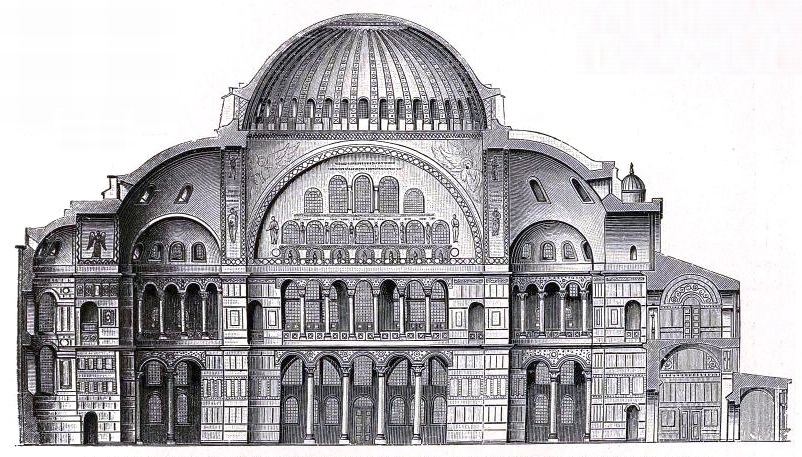 Byzantium
Byzantium
Byzantine art was formed from the Greco-Roman tradition and its combination with oriental elements. It is considered the culmination point of the development of early Christian art, a was born after Constantine moved the capital of the Roman Empire to Byzantium in 330 r. The greatest artistic activity was manifested in the broadly understood church architecture, where we can observe the effects of combining the Hellenic and oriental traditions. Two basic types of Byzantine religious architecture – a basilica and a church on a central plan – arose as a result of the merger of the Greek and Roman temple with the eastern one. Monumental sculpture disappeared in favor of painting and mosaics.
The first period of splendor in the development of Byzantine art and culture was in the times of Justinian the Great, that is, the 6th century. It was then that the Hagia Sophia church was built in Constantinople (God's wisdom), it was then that the art of mosaic arrangement began to develop, known from Roman times, and painting frescoes. They depicted saints, often in the company of rulers, and scenes from the Bible. In addition to sacred architecture, the Byzantines could show off great city fortifications and buildings serving practical purposes. An example of the latter is the Thousand and One Column Basilica Cistern in Istanbul. Moreover, the art of Byzantium also expressed itself through miniature painting, and everyday objects were often masterpieces. The first heyday was halted by the iconoclastic movement (iconoclasm) condemning the cult of images and rejecting, under the influence of Islam, depicting human and animal figures. Iconoclasts have destroyed many works of art, and the new ones were characterized not only by the lack of figural representations, but also the poverty of decoration.
The revival of Byzantine art after the iconoclasm period followed the rejection of earlier resolutions by the Council of Constantinople and a return to the cult of sacred images. At the same time, new trends in architecture emerged, The builders wanted to achieve the effect of lightness in the interior and they wanted to ensure an undisturbed reception of the images conveyed inside. The church was dominated by a dome on a polygonal drum supported by four columns or pillars.
From the 9th century onwards, symbolism played an increasingly important role in Byzantine art. which inevitably began to be accompanied by formalism limiting the independence of artists. Symbolism manifested itself in considering the Church as a micro-cosmos, embracing earth and sky, and all this was expressed in mosaic and painting decorations, in which the colors also began to take on symbolic meanings. Images related to heavenly themes were placed in the upper and eastern parts of the temple. Religious art, despite the formalism of mosaics and frescoes, has reached a high level, provincial monasteries and folk art opposed the formula prohibiting creative interpretation of religious themes (np. rock churches in Cappadocia). The canonization of themes did not include utility items, which began to be decorated all the more. These included beautifully engraved crosses and enamel icons, gold products, ivory, as well as illuminations of books as well as costumes and embroidery on silk (it was the Byzantines who brought silkworm cocoons from China to Europe). Byzantine art then began to radiate far beyond the country's borders: in the Italian architecture of that period one can easily recognize the influence of the Byzantine Empire, even more visible in Armenia and Georgia.
Byzantium was also part of the development of world literature. Eusebius of Caesarea Palestinian wrote at the turn of the third and fourth centuries. the first history of the Christian Church, to whom he owes the name of "the father of church historiography". But the heyday of Christian literature came with the activity of the three so-called. Cappadocian Fathers – Basil the Great, Gregory of Nyssa and Gregory of Nazianz. All of them laid the foundations for the development of Christian humanism in the fourth century., based largely on classicism. In the following centuries, Byzantine literature acquired a theological-dogmatic character and was less and less influenced by classical literature.. Initially, science was concentrated in monasteries, later it was a university dominant, but she could never break free from religion, which was actually the essence of the Byzantine state. Only some of the faculties have reached true heights, like law and medicine, although these were also restrained by the clergy – some claims or sensations were considered heresy.
Influence of Byzantine culture and art reached deep into Asia, and even to central Europe. Numerous archaeological finds and architectural monuments in Poland testify, that already in the Piast times Byzantium had an influence on these areas. These influences can be noted more during the Jagiellonian times, when coming to Lviv and generally in the south-eastern regions of Poland at that time, Armenians were transmitters of this culture. Byzantine traditions and patterns have survived to this day in the Orthodox icon-painting art.